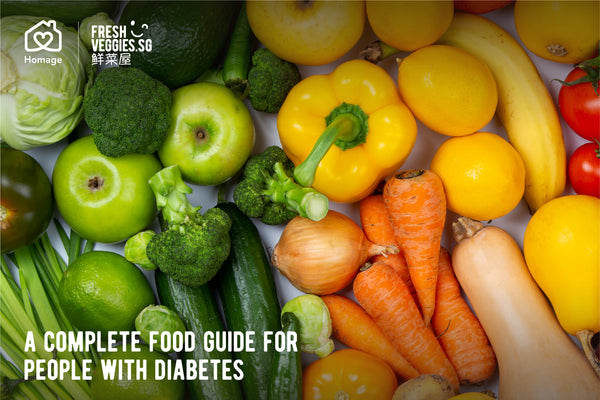When someone is diagnosed with diabetes, their first instinct would be to cut down on sugary foods.

However, sugar restriction is not the one and only goal of a diabetic-friendly diet. For instance, many people with diabetes have impaired kidney function, which means that their diet should ideally be low in sodium, too.
With this, what should you incorporate into your diet to prevent further health complications and maintain your health indicators, such as your cholesterol levels and blood pressure?
Recommended foods for people with diabetes
Vegetables
Vegetables are always on the list when we talk about a healthy, balanced diet. This is because they contain many nutrients, vitamins, minerals, and antioxidants that boost our immune system and prevent micronutrient deficiencies.
However, an optimal diet for people with diabetes would comprise mainly non-starchy vegetables, such as leafy greens. Starchy vegetables should be eaten in moderation.
Non-Starchy Vegetables
- Cabbage
- Carrots
- Green beans
- Asparagus
- Cauliflower
- Broccoli
- Mushrooms
- Onions
- Tomatoes
- Pepper
- Spinach
- Green beans
Starchy Vegetables
- Potatoes
- Peas
- Corns
- Squash
- Beans
- Lentils
- Parsnips
- Pumpkin
- Sweet potato
Fruits
Many believe that because fruits are sweet, they are an unnecessary source of sugar for people with diabetes. However, fruits are also packed with vitamins, minerals, fiber, and antioxidants. Here are some fruits that are great for people with diabetes:
- Apples
- Oranges
- Grapes
- Peaches
- Cherries
- Blueberries
- Grapefruit
- Plums
- Pears
As much as possible, choose fresh fruits. If you are having canned fruits, make sure to drain the syrup first and rinse the fruit to eliminate the added sugar content.
Whole grains
When it comes to your carbohydrates, choose whole grains over refined grains wherever possible. Experts report that whole grains are better for people with diabetes since they contain more fiber, retain more nutrients, and are less likely to cause spikes in your blood sugar level.
Wholegrain products at your local grocery store include:
- Whole oatmeal
- Brown or wild rice
- Quinoa
- Whole-grain cornmeal
- Barley
It will also be beneficial if you can choose "brown" or "whole" instead of "white" food products. This applies to flour, pasta, and bread.
Protein
Protein-rich foods are crucial for internal functions like the production of hormones and enzymes, as well as tissue repair and cell generation.
The best protein choices for people with diabetes are:
- Nuts and seeds
- Beans and lentils
- Eggs
- Cheese
- Seafood
- Poultry like chicken, turkey, and duck without skin
- Lean cuts (cuts with lower fat content) of lamb, pork, and beef
- Meat substitutes, such as tofu
Good fats
Nuts and seeds, such as almonds, hazelnuts, cashews, and peanuts, contain healthy fats that are beneficial for people with diabetes. Other good sources are:
- Cooking oils used in meal preparation. The best choices are canola, olive, and corn oil.
- Avocado and olives
- Mayonnaise
- Salad dressings
Dairy
And finally, dairy products are a good source of calcium to include in your diet. Recommended products typically have "low-fat" or "fat-free" on their labels. Choose from:
- Milk
- Cheese
- Yogurt
Food items to avoid for people with diabetes
While there is no single food item that diabetics cannot eat at all, these types of food should be consumed in limited amounts:
Foods high in sugar
Foods like candies, pastries, ice cream, and milk chocolate can quickly cause blood sugar spikes. Additionally, diabetics need to be careful about "drinking their calories”. Many drinks, such as fruit juices, sodas, and sports drinks, have high amounts of sugar.
Foods high in saturated and trans fats
People with diabetes are already at an increased risk of cardiovascular diseases, such as heart attack and stroke, so doctors would recommend limiting the consumption of "bad fats". Foods that contain high amounts of saturated and trans fats include processed snacks and meats (bacon, hotdogs, sausages, etc.), animal protein such as butter, and coconut oil.
Foods high in sodium
Sodium or salt retain excess water in the body, adding burden to the heart and increasing the risk of high blood pressure. The usual limit is 2,300 mg of salt for the whole day.
As many foods already contain salts naturally, consider using herbs, spices, and other salt-free or low-sodium seasonings to boost the flavours of your food instead.
A note on the food recommendations
Please keep in mind that the above-mentioned foods are generic recommendations. Your dietitian or nutritionist’s recommendations for you may vary, depending on your health needs and dietary preferences.
Furthermore, the recommendations may change depending on the presence of other health conditions. For instance, diabetic patients who also have hypertension may be subject to stricter restrictions on sodium consumption. Those with kidney conditions may be advised to monitor their fluid intake as well.
If in doubt, consult your doctor, nutritionist, or dietitian.
Creating your diabetic food plan
When to eat: Why meal schedules matter
Most healthy people have 3 main meals and a few snacks throughout the day. They may skip a meal or two and will not experience any adverse effects.
However, when a person with diabetes skips a meal, it may cause low blood sugar (hypoglycemia), which can be dangerous.
To avoid this, most people with diabetes have regular mealtimes with a set amount of carbohydrates. Others find that grazing small meals throughout the day helps because:
- It gives them a constant source of energy
- They are less likely to feel hungry and overeat in their next meal
- It helps them to regulate their blood sugar levels throughout the day
Please be advised that since mealtimes are highly connected with your medications and insulin shots, you will need to consult your doctor before changing your meal schedule.
How much to eat: Controlling food portions
The Plate Method
Think of this strategy as a diabetes diet food chart but contained in a plate. Follow the instructions below.
- For main meals, usually, lunch and dinner, prepare a 9-inch plate.
- Fill ½ of the plate with non-starchy veggies.
- Fill ¼ of the plate with protein foods.
- And finally, fill the other ¼ of the plate with starchy vegetables or grains.
- You can have a piece of fruit or a bowl of fruits on the side.
- For drinks, you can have a glass of milk along with water.
And that’s it!
2. Using Portion Sizes
In creating a diabetic-friendly meal plan, the right portion sizes are key. To put things into perspective, consider rice.
Many people have a cup of rice per meal. However, a recommended serving of cooked rice for people with diabetes is only about ⅓ cup. A person with diabetes who has a full cup of cooked rice has essentially had 3 servings of it in one go.
Below are the recommended portion sizes (1 serving):
- ½ cup of cooked cereal or pasta
- 1 slice of bread
- 1 small potato; ½ if it is larger-sized
- 1 cup of raw veggies
- ½ cup of cooked vegetables
- 1 small fruit
- Meat or poultry about the size of a palm
We hope that this guide has been helpful in illuminating what a diabetic-friendly diet can look like for you. However, the best course of action before changing what you eat is to consult your doctor, dietitian, or nutritionist. As experts, they will teach you how to properly read food labels and select the best food options for your lifestyle, preferences, and health requirements.
This article first appeared on Homage, an award-winning personal care solution that provides on-demand holistic home and community-based caregiving and medical services to seniors and adults, allowing them to age and recover with grace, control, and dignity.
References
- Alcohol: Balancing risks and benefits. (2019, June 14). The Nutrition Source. Retrieved February 16, 2021, from https://www.hsph.harvard.edu/nutritionsource/healthy-drinks/drinks-to-consume-in-moderation/alcohol-full-story/
- Best Foods for You: Healthy Food Choices for People with Diabetes. (n.d.). American Diabetes Association:. Retrieved February 16, 2021, from https://main.diabetes.org/dorg/PDFs/awareness-programs/hhm/what_can_i_eat-best_foods-American_Diabetes_Association.pdf
- Diabetes diet, eating, & physical activity. (2016, December 1). National Institute of Diabetes and Digestive and Kidney Diseases. Retrieved February 17, 2021, from https://www.niddk.nih.gov/health-information/diabetes/overview/diet-eating-physical-activity#when
- Diabetes diet: Create your healthy-eating plan. (2019, February 19). Mayo Clinic. Retrieved February 16, 2021, from https://www.mayoclinic.org/diseases-conditions/diabetes/in-depth/diabetes-diet/art-20044295
- Diabetes — What to eat, how much, and when | Kaiser Permanente Washington. (n.d.). Kaiser Permanente Washington. Retrieved February 17, 2021, from https://wa.kaiserpermanente.org/healthAndWellness/index.jhtml?item=%2Fcommon%2FhealthAndWellness%2Fconditions%2Fdiabetes%2FmealSchedule.html
- Diabetic diet. (n.d.). MedlinePlus - Health Information from the National Library of Medicine. Retrieved February 17, 2021, from https://medlineplus.gov/diabeticdiet.html
- Nutrition principles and recommendations in diabetes. (2004, January 1). Diabetes Care. Retrieved February 16, 2021, from https://care.diabetesjournals.org/content/27/suppl_1/s36
- Whole grains. (2020, March 9). Diabetes. Retrieved February 16, 2021, from https://www.diabetes.co.uk/food/diabetes-and-whole-grains.html#:~:text=The%20nutritional%20benefits%20of%20whole,of%20minerals%3B%20magnesium%20and%20zinc

Leave a comment